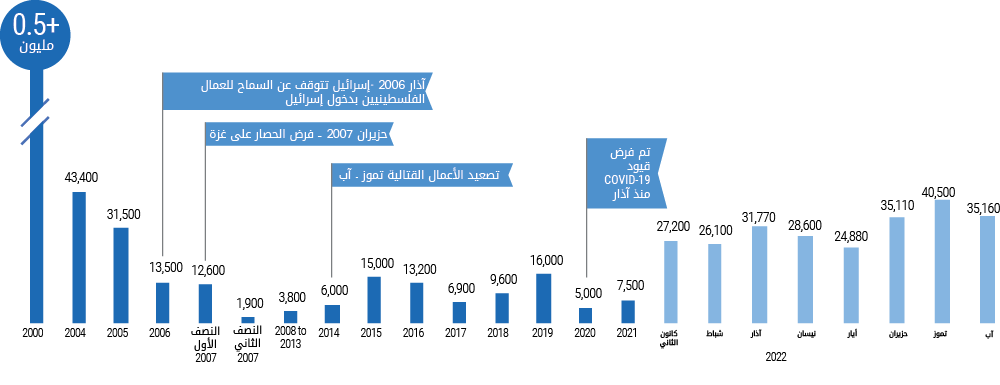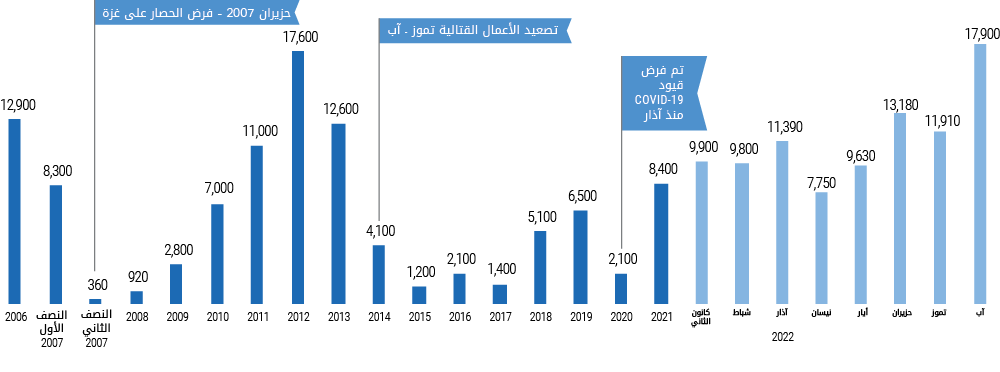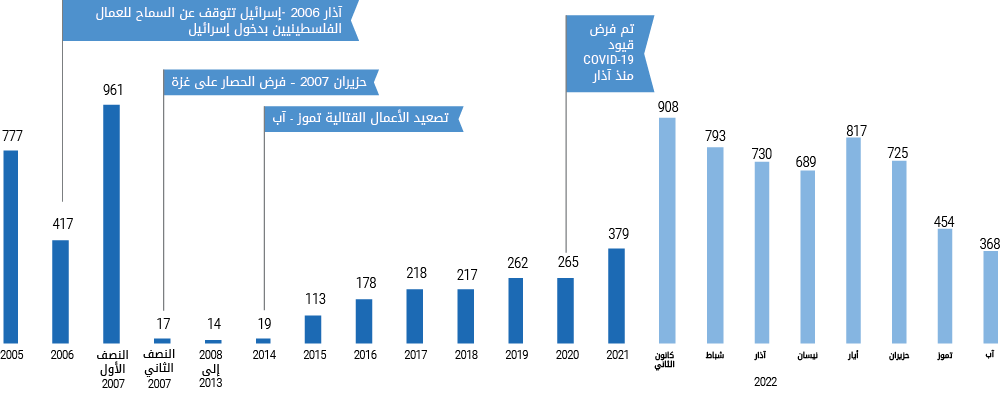التنقل داخل غزة ومنها إلى خارجها: تقرير محَّدث يغطي شهر آب/أغسطس 2022
أبرز الأحداث
- في 2-7 آب/أغسطس، أغلقت السلطات الإسرائيلية حدودها مع غزة بحجة المخاوف الأمنية، ومنعت أي حركة للأفراد أو البضائع. وقد دار تصعيد للأعمال القتالية في 5-7 آب/أغسطس.
- أجبر الإغلاق محطة غزة لتوليد الكهرباء، التي تعتمد على واردات الوقود، على تعطيل عملها لمدة يومين.
- في الإجمال، سجل شهر آب/أغسطس 2022 خروج عدد أقل من الأفراد والبضائع من غزة إلى إسرائيل أو عبرها بالمقارنة مع تموز/يوليو. كما خرجت كميات أقل من البضائع إلى مصر.
- ومع ذلك، غادر عدد أكبر من الفلسطينيين إلى مصر بالمقارنة مع أي شهر بمفرده منذ تموز/يوليو 2013 ودخلت كميات أكبر من البضائع غزة عبر مصر أو إسرائيل بالمقارنة مع تموز/يوليو.
الخلفية: تقوّض القيود المفروضة منذ أمد بعيد على حركة الأفراد والبضائع إلى غزة ومنها إلى خارجها الظروف المعيشية لدى سكانها الذين يزيد تعدادهم عن مليوني نسمة في القطاع. وقد جرى تشديد العديد من القيود الحالية، التي فرضتها السلطات الإسرائيلية في الأصل في مطلع العقد الأخير من القرن الماضي، وذلك بعد حزيران/يونيو 2007 عقب استيلاء حركة حماس على قطاع غزة عندما فرضت السلطات الإسرائيلية الحصار عليه. ولا تزال هذه القيود تحد من القدرة على الوصول إلى سبل العيش والخدمات الأساسية والسكن، وتعوق الحياة الأسرية وتقوض آمال الناس في مستقبل يعمّه الأمن والرخاء. كما تفاقم الوضع بفعل القيود التي تفرضها السلطات المصرية على معبر رفح.
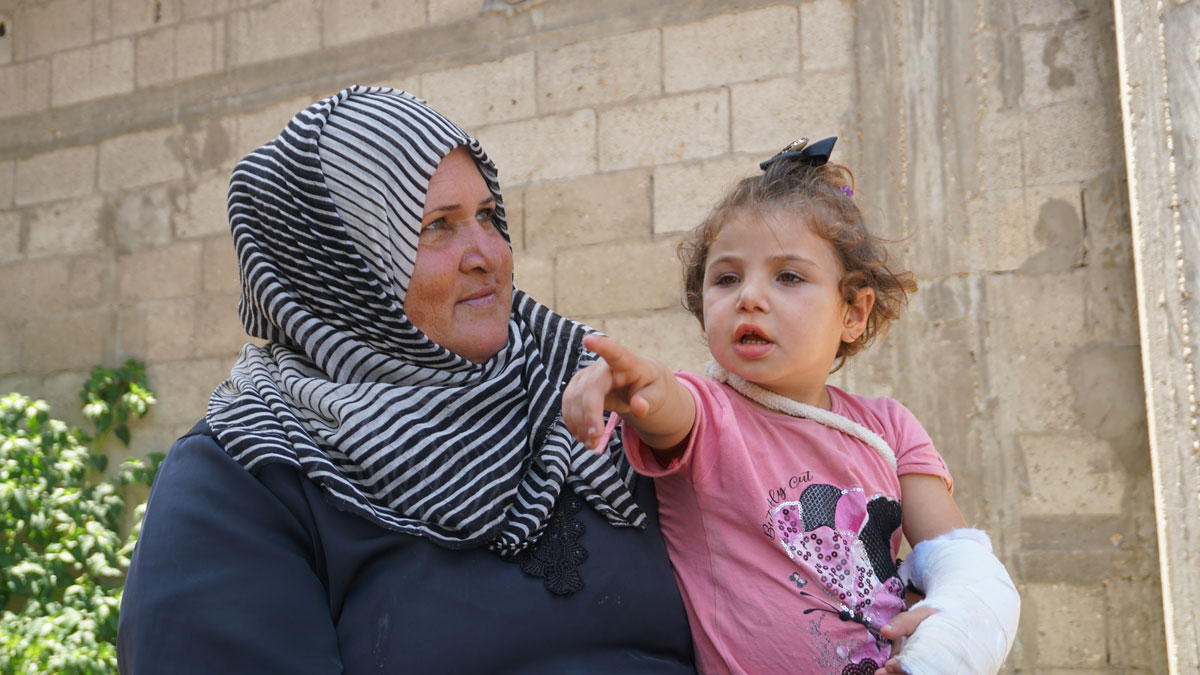
احتاجت أحلام البالغة من العمر خمس سنوات إلى علاج طبي غير متوفر في غزة، لكن طلب تصريح خروج والديها تأخر لعدة أشهر، حتى تدخل الشركاء الإنسانيون. في أوائل آب/أغسطس، كانت هي ووالدتها في مستشفى بالقدس بينما تصاعدت الأعمال العدائية في منطقة سكنهما. تصوير مكتب تنسيق الشؤون الإنسانية (OCHA)
تنقل الأفراد إلى إسرائيل والضفة الغربية
- في 2-7 آب/أغسطس، أغلقت السلطات الإسرائيلية حدودها مع غزة بحجة المخاوف الأمنية، قبل تصعيد الأعمال القتالية التي دارت بين يومي 5 و7 آب/أغسطس وخلالها.
- في الإجمال، سمحت السلطات الإسرائيلية لنحو 35,160 شخصًا بمغادرة غزة في آب/أغسطس (حيث غادر المسافرون في مرات متعددة في معظم الحالات). ويمثل ذلك انخفاضًا قدره 14 بالمائة عن عدد حالات المغادرة في تموز/يوليو، ولكنه زاد بنحو أربعة أضعاف عن المتوسط الشهري في 2021. ومع ذلك، لا يمثل هذا العدد سوى 7 بالمائة تقريبًا من المتوسط الشهري لحالات المغادرة قبل فرض القيود على أساس الفئات في العام 2000.
- شكّل الفلسطينيون الذي سُمح لهم بالمغادرة ضمن فئة «التجار» أو «الاحتياجات الاقتصادية» نحو 86 بالمائة من حالات المغادرة، ومعظم هؤلاء يعملون بصفتهم عمال مياومة في إسرائيل.
- مثّل المرضى المحالون للعلاج الطبي في الضفة الغربية أو إسرائيل ومرافقوهم نحو 7 بالمائة من حالات المغادرة. وقُدِّم ما مجموعه 2,067 طلبًا للحصول على تصاريح المغادرة لحضور المواعيد الطبية المقررة في آب/أغسطس، ولكن لم تصدر الموافقة إلا على 42 بالمائة منها في الوقت المطلوب.
الخلفية: يُمنع الفلسطينيون من مغادرة غزة عبر إسرائيل، بما يشمل المرور منها إلى الضفة الغربية، ما لم يحصلوا على تصاريح الخروج التي تصدرها السلطات الإسرائيلية. ولا يستطيع سوى الأشخاص الذين ينتمون إلى فئات محددة، ولا سيما التجار (بمن فيهم عمال المياومة)، والمرضى ومرافقوهم والعاملون في مجال الإغاثة، تقديم الطلبات للحصول على هذه التصاريح. ولا يُعدّ الأشخاص الآخرون مؤهلين للحصول على التصاريح، حتى لو لم يكونوا يشكلون خطرًا أمنيًا، وفقًا للسلطات الإسرائيلية. وفي معظم الحالات، لا تبدي السلطات الإسرائيلية أسبابًا محددة لرفض طلبات التصاريح. وفي حال الموافقة على طلب من هذه الطلبات، يجوز لحامل التصريح أن يسافر عبر معبر إيريز الذي تسيطر إسرائيل عليه، من الأحد حتى الخميس، وفي أيام الجمعة للحالات الطارئة وللرعايا الأجانب دون غيرهم.
تنقل الأفراد إلى مصر
- سمحت السلطات المصرية لنحو 17,900 شخص بمغادرة غزة في آب/أغسطس (ومن الممكن أن بعض المسافرين غادروا في مرات متعددة). وهذا هو أعلى عدد من حالات المغادرة إلى مصر منذ تموز/يوليو 2013، ويمثل زيادة قدرها 50 بالمائة عن عدد من سُمح لهم بالمغادرة في تموز/يوليو، كما زاد عن ضعفي المتوسط الشهري في 2021، عندما فُرضت القيود في سياق جائحة كورونا على نطاق واسع. ويعزى هذا الارتفاع إلى انتهاء العطلة الصيفية، حيث يعود الزوار إلى البلدان التي يقيمون فيها.
- منعت السلطات المصرية نحو 486 شخصًا من دخول مصر في تموز/يوليو، بالمقارنة مع 271 حالة منع في تموز/يوليو 2022.
الخلفية: يتعين على الفلسطينيين الذين يرغبون في مغادرة غزة عبر مصر التسجيل لدى السلطات الفلسطينية المحلية قبل أسبوعين إلى أربعة أسابيع سلفًا. ويجوز للأشخاص تقديم طلبات إلى السلطات المصرية مباشرة بالاستفادة من الخدمات التي تقدمها شركة محلية. وتفتقر الإجراءات والقرارات التي تتخذها السلطات الفلسطينية والمصرية إلى الشفافية. ويغادر الأشخاص الذين تصدر الموافقة على طلباتهم عبر معبر رفح، الذي تسيطر السلطات المصرية عليه ويعمل من الأحد حتى الخميس. وغالبًا ما تكون الرحلة إلى القاهرة عبر صحراء سيناء طويلة وتشهد التوقف مرات عديدة للفحص من جانب القوات الأمنية المصرية.
البضائع الواردة
إجمالي البضائع (باستثناء الوقود والغاز)
- في 2-7 آب/أغسطس، أغلقت السلطات الإسرائيلية حدودها مع غزة بحجة المخاوف الأمنية، قبل تصعيد الأعمال القتالية التي دارت بين يومي 5 و7 آب/أغسطس وخلالها.
- في الإجمال، دخلت 9,155 شاحنة محملة بالبضائع غزة، وهو ما يمثل زيادة قدرها 29 بالمائة عن تموز/يوليو و16 بالمائة عن المتوسط الشهري في 2021. ومع ذلك، كانت هذه الكميات أقل بـ18 بالمائة من المتوسط الشهري المسجل عشية فرض الحصار في 2007، على الرغم من أن تعداد سكان غزة زاد بأكثر من 55 بالمائة منذ ذلك الحين.
- شكلت مواد البناء 43 بالمائة من البضائع الواردة والمواد الغذائية 23 بالمائة منها. وتضمن نحو 4 بالمائة من البضائع مساعدات إنسانية يسرتها المنظمات الدولية، بما فيها الأغذية واللوازم الطبية.
- وُرد نحو 61 بالمائة من البضائع عبر إسرائيل. وكانت هذه الكمية أعلى بـ15 بالمائة من الكمية التي وردت في الشهر السابق وأقل بـ17 بالمائة من المتوسط الشهري المسجل في 2021.
- شكلت مواد البناء أكثر من 23 بالمائة من البضائع الواردة عبر إسرائيل (الحصمة والإسمنت والحديد المسلح أساسًا). وكانت هذه الكمية أقل بـ57 بالمائة من المتوسط الشهري المسجل في 2021.
- ورد نحو 39 بالمائة من إجمالي البضائع عبر مصر، حيث استوردت هذه البضائع منها على مدى 13 يومًا. وكانت كمية هذه البضائع أعلى بما نسبته 59 بالمائة الكمية المستوردة في تموز/يوليو، وأكثر من ضعفي المتوسط الشهري المسجل في 2021.
- شكلت مواد البناء أكثر من 72 بالمائة من البضائع الواردة من مصر. وشكلت الأغذية معظم البضائع المتبقية.
الخلفية: منذ فرض الحصار في 2007، قيدت السلطات الإسرائيلية دخول البضائع التي ترى أن لها استخدامًا مزدوجًا (مدنيًا وعسكريًا)، كمواد البناء والمعدات الطبية وبعض المواد الزراعية، إلى غزة. وقد يُسمح بدخول بعض هذه البضائع بعد إجراءات طويلة من الطلبات والمراجعات. ولا يمكن دخول جميع البضائع من إسرائيل أو عبرها (بما فيها البضائع غير المقيدة) إلا من خلال معبر كرم أبو سالم بعد التنسيق المسبق. ومنذ 2018، لا تزال البضائع تدخل غزة بانتظام من مصر عبر معبر رفح، ثم عبر بوابة صلاح الدين المجاورة التي تقع سيطرة السلطات الإسرائيلية.
المتوسط الشهري للبضائع الواردة إلى غزة
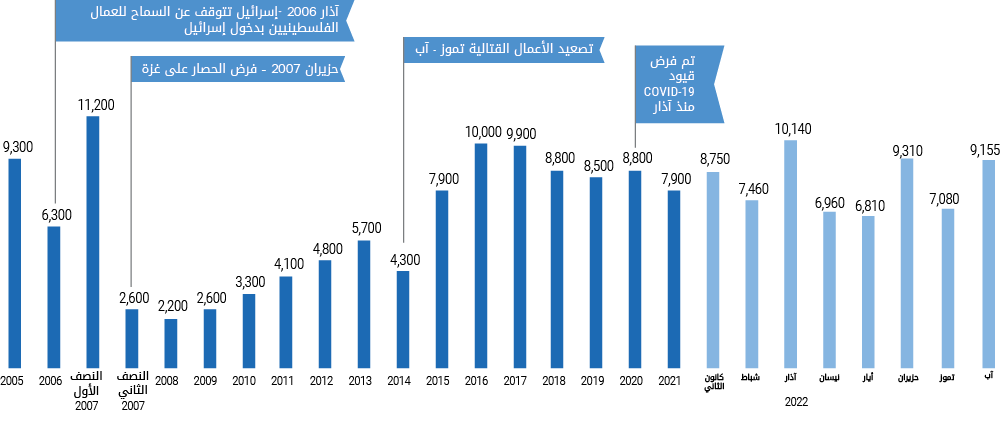
الوقود والغاز
- زادت كميات البنزين والسولار التي دخلت غزة من إسرائيل ومصر خلال آب/أغسطس 2022 بـ38 بالمائة بالمقارنة مع تموز/يوليو، وكانت أعلى بـ6 بالمائة من المتوسط الشهري في 2021.
- شهدت كميات السولار الصناعي المخصص لمحطة توليد الكهرباء انخفاضًا طفيفًا بالمقارنة مع تموز/يوليو. ومع ذلك، مثلت هذه الكميات زيادة قدرها 5 بالمائة بالمقارنة مع المتوسط الشهري في 2021. وقد اضطرت المحطة إلى تعطيل عملها لمدة يومين بسبب نقص الوقود عند نهاية الإغلاق الذي فرضته إسرائيل بين يومي 2 و7 آب/أغسطس.
- زادت كميات غاز الطهي زيادة طفيفة بالمقارنة مع تموز/يوليو. ومع ذلك، كان حجم هذه الواردات أعلى بـ10 بالمائة بالمقارنة مع المتوسط الشهري في 2021.
البضائع الصادرة
- في آب/أغسطس، سمحت السلطات الإسرائيلية بخروج 192 شاحنة محملة بالبضائع من غزة، وهي نسبة تقل بـ27 بالمائة عن الشهر السابق وتعد الأقل منذ مطلع العام 2022. كما كان هذا العدد أقل بـ80 بالمائة من المتوسط الشهري المسجل عشية فرض الحصار في 2007.
- فرضت السلطات الإسرائيلية قيودًا مشددة على تصدير الأسماك في آب/أغسطس.
- صُدر نحو 33 بالمائة من البضائع الصادرة إلى الضفة الغربية و67 بالمائة إلى إسرائيل. وشكلت الخضار 62 بالمائة والمنسوجات 19 بالمائة من هذه البضائع، على حين شمل ما تبقى منها الأسماك والألومنيوم وخردة النحاس والأثاث.
- خرجت 176 شاحنة أخرى محملة بحديد الخردة وخردة النحاس وخردة الألومنيوم المستعمل والبطاريات المستعملة من غزة إلى مصر. ويمثل ذلك انخفاضًا قدره 9 بالمائة عن الشهر السابق.
الخلفية: تنقل غالبية المنتجات المتداولة خارج غزة إلى الأسواق عبر معبر كرم أبو سالم الذي تسيطر إسرائيل عليه، حيث تسري قيود مختلفة عليها. ومنعت السلطات الإسرائيلية خروج البضائع إلى الضفة الغربية وإسرائيل، اللتين تمثلان الأسواق الرئيسية، إلى حد كبير بين العامين 2007 و2014، ثم أعادت تصديرها بالتدريج. ومنذ آب/أغسطس 2021، لا تزال بعض البضائع تصدر إلى مصر عبر بوابة صلاح الدين ومعبر رفح.
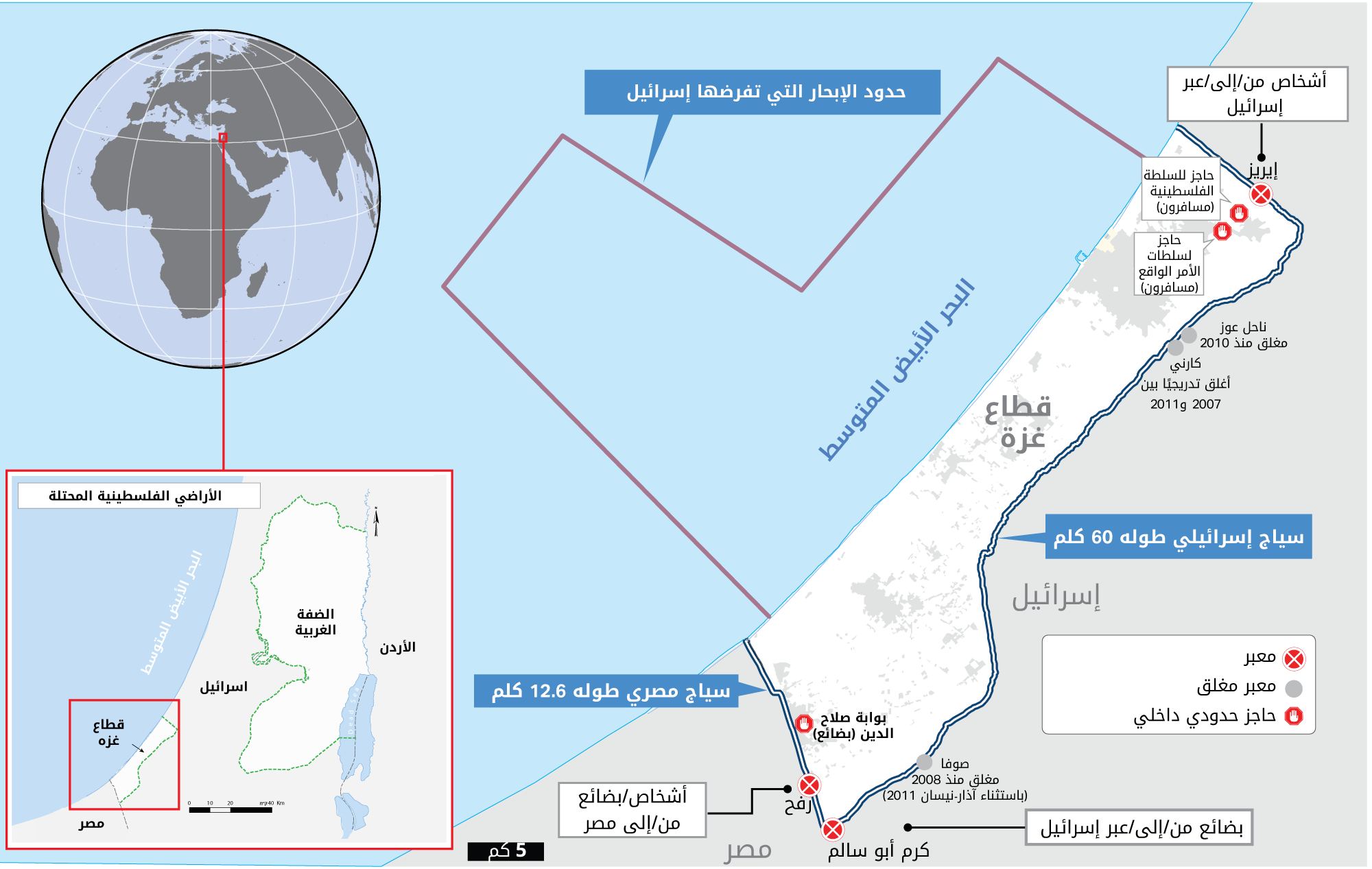
مصدر البيانات: وزارة الاقتصاد الوطني في غزة. للمزيد من البيانات: ochaopt.org/data/crossings
